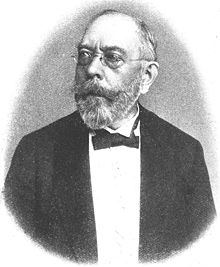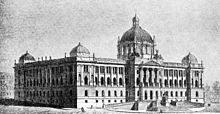Josef Schulz (architect)
Josef Schulz (born April 11, 1840 in Prague , † July 15, 1917 in Špindlerův Mlýn (Spindleruv Mlyn, Bohemia , Austria-Hungary ), according to another source in Prague, see literature: Collegium Carolinum (Institute) ) was an important Czech architect and designer .
Life
Josef Schulz, possibly identical to Josef Bernhard Schulz (Wurzbach, Volume 32), studied from 1861 to 1865 at the Academy of Fine Arts in Vienna and from 1864 to 1868 in Prague architecture a . a. with Josef Zitek. From 1864 to 1868 he was an assistant in the architecture department of the Prague Polytechnic and obtained the degree of Dr.techn., Which was followed by study visits to Italy between 1868 and 1870 . From 1871 he was a freelance architect in Prague, in 1874 Schulz became a teacher at the Prague Goldsmith School and from 1878 a full professor of architecture at the Prague Czech University , while still taking on assignments as a freelance architect and representing the neo-renaissance style in his building plans . He was a member of the state examination commission for building construction and a member of the art council of the Vienna Ministry of Culture and Education.
Construction contracts and works
Josef Schulz is one of the most successful Czech architects of historicism with a particular preference for the Neo-Renaissance in the period before the First World War. His works include numerous apartment buildings in the center of Prague and Smíchov and restorations (including the Schwarzenberg Palace ). He was a founding member of the Bohemian Kaiser Franz Josef Academy of Sciences, Literature and Arts in Prague and was accepted as a member of the Royal Bohemian Society of Sciences .
Josef Schulz designed important buildings in Bohemia , including Prague, the National Museum and the Museum of Decorative Arts , the Museum of Industrial Art, and together with his teacher Josef Zítek the Rudolfinum and the Town Hall in Smichov (1874). After the devastating fire of the National Theater on August 13, 1881, it was rebuilt in the following years under his direction. Other projects were villas in Loučim and Bodenbach on the Elbe (Podmokly) near Decin (Tetschen) in northern Bohemia (Palais Trauttmansdorff , Palais Jordan, construction contract from the manufacturer Franz Jordan (1828–1884), destroyed when the Red Army marched in May 1945) . In addition, he promoted the Bohemian garden architecture. As a restorer , he renewed scratch paintings in the Palais Schwarzenberg in Prague Castle , the Prague Castle , remains the Buquoypalais and the Wallenstein Palace in Prague, locks in Strahov on the Lesser Town , Hrubá Skála , Vrchlabi and Bischofteinitz in West Bohemia , churches in Maršov , Uherské Hradiště and Strahov . His drafts were mostly based on historical templates and shaped their uniform, representative image.
recognition
Josef Schulz was appointed Hofrat , received the Knight's Cross of the Franz Joseph Order in 1884 and the Imperial Austrian Order of the Iron Crown (Austria) III in 1906 . 1st class in the Austro-Hungarian monarchy .
literature
- Ferdinand Seibt , Hans Lemberg , Helmut Slapnicka: Biographical lexicon on the history of the Bohemian countries. Published on behalf of the Collegium Carolinum (Institute) , Vol. III, R. Oldenbourg Verlag Munich 2000, ISBN 3-486-55973-7 , p. 787, with further references in Czech-language literature
- Constantin von Wurzbach : Schulz, Joseph Bernhard . In: Biographisches Lexikon des Kaiserthums Oesterreich . 32nd part. Kaiserlich-Königliche Hof- und Staatsdruckerei, Vienna 1876, p. 203 ( digitized version ).
- D. Klein: Schulz Josef. In: Austrian Biographical Lexicon 1815–1950 (ÖBL). Volume 11, Verlag der Österreichischen Akademie der Wissenschaften, Vienna 1999, ISBN 3-7001-2803-7 , p. 347 f. (Direct links on p. 347 , p. 348 ).
- Wiener Zeitung July 19, 1917
Web links
- Josef Schulz (architect). In: arch INFORM .
- Literature and other media by and about Josef Schulz (architect) in the catalog of the National Library of the Czech Republic
Individual evidence
- ↑ Příruční slovník naučný: Schulz Josef , Nakladatelstí Československé akademie věd, Prague 1967, Part IV, p. 70.
- ^ František Kop: Národní museum, Prague 1941, p. 63f.
| personal data | |
|---|---|
| SURNAME | Schulz, Josef |
| BRIEF DESCRIPTION | Czech architect |
| DATE OF BIRTH | April 11, 1840 |
| PLACE OF BIRTH | Prague |
| DATE OF DEATH | July 15, 1917 |
| Place of death | Špindlerův Mlýn |

